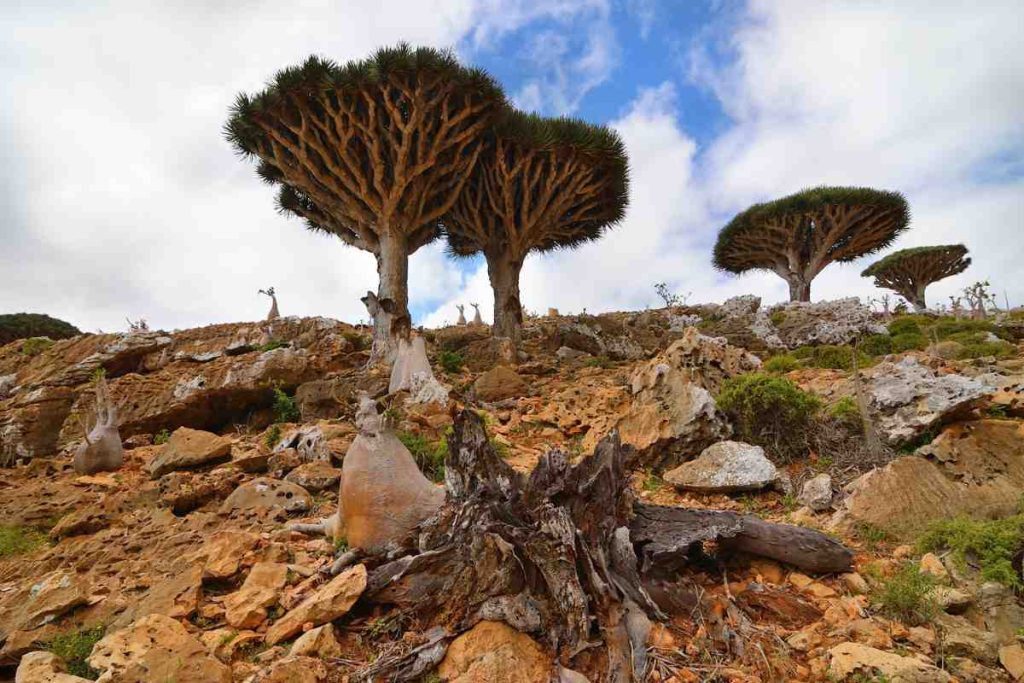The oldest Dragon’s Blood Tree, also known as Dracaena Cinnabari, is a fascinating and enigmatic species that has captured the imagination of people for centuries. This ancient tree is found in the ancient kingdom of Socotra, an archipelago located in the Arabian Sea. The allure and mystery surrounding the Dragon’s Blood Tree lie not only in its age but also in its unique characteristics and cultural significance. In this article, we will delve into the wonders of the oldest Dragon’s Blood Tree, uncovering its ancient roots, exploring its habitat, and discussing the importance of its preservation.
The Ancient Kingdom: Unveiling the Enchanting Land of Dragon’s Blood Trees
The ancient kingdom of Socotra is a remote and isolated archipelago that is part of Yemen. It is located in the Arabian Sea, off the coast of Somalia and Ethiopia. The island is known for its unique and diverse flora and fauna, with over 700 species found nowhere else on Earth. One of the most iconic features of Socotra is its Dragon’s Blood Trees, which dot the landscape with their striking and otherworldly appearance.
The landscape of Socotra is truly enchanting, with rugged mountains, deep canyons, and pristine beaches. The Dragon’s Blood Trees thrive in this harsh and arid environment, where they have adapted to survive in extreme conditions. The trees can be found scattered across the island, but they are most concentrated in the central highlands. The sight of these ancient trees against the backdrop of the dramatic landscape is truly awe-inspiring.
A Botanical Wonder: Discovering the Unique Characteristics of the Dragon’s Blood Tree
The Dragon’s Blood Tree is a botanical wonder with its distinctive shape, size, and red resin. It is a slow-growing tree that can reach heights of up to 10 meters. Its trunk is thick and stout, with branches that spread out like an umbrella. The leaves are long and slender, resembling a crown of greenery at the top of the tree.
One of the most striking features of the Dragon’s Blood Tree is its red resin, which gives the tree its name. When the bark of the tree is cut or damaged, it oozes a deep red sap that has been used for centuries in traditional medicine and dyes. The resin has also been associated with mythical properties and legends, which we will explore later in this article.
The unique characteristics of the Dragon’s Blood Tree make it a botanical wonder and a sight to behold. Its ancient and otherworldly appearance adds to its allure and mystery, making it a must-see for nature enthusiasts and adventurers alike.
Unraveling the Origins: Tracing the Ancient Roots of the Dragon’s Blood Tree
The origins of the Dragon’s Blood Tree can be traced back millions of years. It is believed to be a relic species from the time when Socotra was part of the supercontinent Gondwana. The isolation of Socotra allowed the Dragon’s Blood Tree to evolve independently, resulting in its unique characteristics and adaptations.
Scientific research has shed some light on the evolutionary history of the Dragon’s Blood Tree. DNA analysis has revealed that it is closely related to other Dracaena species found in Africa and Arabia. This suggests that the tree’s ancestors may have migrated to Socotra from mainland Africa or Arabia.
While there is still much to learn about the ancient roots of the Dragon’s Blood Tree, its presence on Socotra is a testament to its resilience and ability to adapt to harsh environments over millions of years.
The Legend of Dragon’s Blood: Unveiling the Mythical Properties of the Tree’s Resin
The red resin of the Dragon’s Blood Tree has long been associated with mythical properties and legends. In ancient times, it was believed to have magical and healing powers. The resin was used in traditional medicine to treat various ailments, including wounds, digestive issues, and respiratory problems.
In addition to its medicinal uses, the resin of the Dragon’s Blood Tree has also been used as a dye and a varnish. It was highly prized for its vibrant red color and its ability to preserve wood and other materials. The resin was also used in religious ceremonies and rituals, where it was believed to ward off evil spirits and bring good luck.
The legends surrounding the Dragon’s Blood Tree’s resin have contributed to its cultural significance. It is considered a symbol of strength, protection, and vitality in the local traditions and customs of Socotra.
Threats to Survival: Understanding the Challenges Faced by the Oldest Dragon’s Blood Trees

Despite their resilience and adaptability, the oldest Dragon’s Blood Trees face numerous threats to their survival. Climate change is one of the biggest challenges, as it is causing shifts in temperature and rainfall patterns on Socotra. These changes can negatively impact the growth and reproduction of the trees, making it difficult for them to survive.
Habitat destruction is another major threat to the oldest Dragon’s Blood Trees. Socotra is experiencing increased human activity, including deforestation, agriculture, and urbanization. These activities are encroaching on the natural habitat of the trees, reducing their available space and resources.
Invasive species are also posing a threat to the Dragon’s Blood Trees. Non-native plants and animals can outcompete the native species for resources, disrupting the delicate balance of the ecosystem.
Conservation Efforts: Preserving the Legacy of the Ancient Kingdom’s Iconic Tree
Recognizing the importance of preserving the oldest Dragon’s Blood Trees, there have been efforts made to protect them and their habitat. The Socotra Conservation and Development Program (SCDP) is one such initiative that aims to conserve the unique biodiversity of Socotra, including the Dragon’s Blood Trees.
The SCDP works with local communities to raise awareness about the importance of conservation and sustainable practices. They also conduct research and monitoring to better understand the threats facing the trees and develop strategies for their protection.
Other organizations, such as the Socotra Archipelago Foundation, are also working towards the preservation of the Dragon’s Blood Trees. These efforts include habitat restoration, reforestation, and the establishment of protected areas.
Exploring the Habitat: Venturing into the Enigmatic Forests of the Dragon’s Blood Tree
For those who wish to experience the beauty of the Dragon’s Blood Trees firsthand, visiting Socotra is a must. The island offers a unique opportunity to explore an ancient and untouched landscape, where time seems to stand still.
To visit the habitat of the Dragon’s Blood Trees, it is recommended to hire a local guide who is familiar with the area. They can provide valuable insights into the flora and fauna of Socotra and ensure that visitors follow responsible tourism practices.
When exploring the forests of the Dragon’s Blood Tree, it is important to respect the environment and leave no trace. This means not disturbing or damaging the trees or their surroundings, and taking any trash or waste with you when you leave.
Cultural Significance: Uncovering the Role of the Dragon’s Blood Tree in Local Traditions
The Dragon’s Blood Tree holds great cultural significance in the local traditions and customs of Socotra. It is considered a sacred tree and is often associated with rituals and ceremonies.
One such ceremony is the annual Dragon’s Blood Festival, which takes place in February. During this festival, locals gather around a large Dragon’s Blood Tree and perform traditional dances and songs. The resin of the tree is also used in religious rituals, where it is believed to bring blessings and protection.
The Dragon’s Blood Tree is deeply ingrained in the cultural identity of Socotra, and its preservation is seen as a way to protect and honor the ancient traditions of the island.
Future Prospects: Promoting Sustainable Tourism to Protect the Oldest Dragon’s Blood Trees
Sustainable tourism plays a crucial role in protecting the oldest Dragon’s Blood Trees and their habitat. By promoting responsible travel practices, visitors can minimize their impact on the environment and contribute to the preservation of the trees.
Some ways that tourists can support the conservation of the Dragon’s Blood Trees include:
1. Choosing eco-friendly accommodations that prioritize sustainability and conservation.
2. Supporting local businesses and communities by purchasing locally made products and services.
3. Following designated trails and paths when exploring the forests to avoid damaging the trees or their surroundings.
4. Respecting the local customs and traditions, including any guidelines or restrictions related to the Dragon’s Blood Trees.
5. Educating themselves about the importance of conservation and sharing their knowledge with others.
By adopting these practices, tourists can help ensure that future generations will be able to experience the beauty and wonder of the oldest Dragon’s Blood Trees.
Reflecting on the Mysteries and Importance of the Oldest Dragon’s Blood Tree
The oldest Dragon’s Blood Tree is a true marvel of nature, with its ancient roots, unique characteristics, and cultural significance. It is a testament to the resilience and adaptability of life on Earth, as well as a reminder of our responsibility to protect and preserve our natural heritage.
As we continue to explore and unravel the mysteries of the oldest Dragon’s Blood Tree, it is important to remember that its survival depends on our actions. By supporting conservation efforts, practicing responsible tourism, and raising awareness about its importance, we can ensure that this ancient tree continues to inspire awe and wonder for generations to come.

Leave a Reply